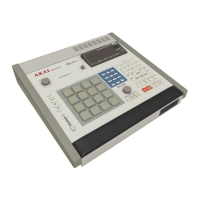48
3.6 An example of recording a drum sequence
The MPC60 is both a "linear" type sequences and a "pattern oriented"
sequences. The following examples use short sequences with the loop
function turned on, and are therefore examples of "pattern-oriented"
recording. To record linearly, simply set the LOOP field (in the
PLAY/RECORD screen) to "OFF". Then, the sequence length will
automatically increase as you record past the existing end. See the
description of the LOOP field to learn more about this.
The following is a step-by -step example of how to record a repeating two
bar drum sequence:
1.The PLAY/RECORD screen should be displayed. If not, press
MAIN SCREEN.
2. Move the cursor to the SQNC field and select 80 (ENTER) or any
other empty sequence.
3. The upper line of the screen should display:
"====== Play/Record (Record ready) ======"
If not, press either the RECORD or OVERDUB keys once. This will
make the current sequence ready for recording.
4. The TRAKfield should contain a 1. If not, move the cursor to the
TRAK field and select 1 (ENTER).
5. The upper CH field should contain "16A". If not, move the cursor to
the upper CH field and select "16" (Enter), and "A" in the field directly
to the right.
6. While holding OVERDUB, press PLAY START. The OVERDUB and
PLAY lights should go on, and the metronome should be heard through
the stereo outputs. The metronome will play on 1/4 notes, with a louder
sound at the start of each bar. Also, the NOW display will be constantly
changing to reflect the current position within the sequence.
7. Start recording your drum pattern by playing the drum pads in time to the
metronome. Since no specific format of time signature or number of bars
has been entered, "repeat two bars of 4/4 time" has automatically been
selected. Every time the two bar pattern loops back to the start, any
drums recorded on the last pass will be heard at the position they were
recorded, except that the TIMING CORRECT function has
automatically moved all of your notes to

